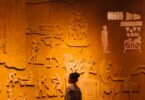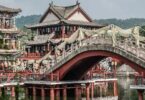Ancient Spice Trade Routes Questions and Answers:
The Silk Road connected which two major empires during its prime?
(a) The Roman Empire and Han Dynasty
(b) The Ottoman Empire and the Tang Empire
(c) Aztec Empire and Inca Empire
(d) The Persian Empire and the Byzantine Empire
Which region was a significant crossroads along spice and silk route trade networks?
(a) Southeast Asia
(b) Sub-Saharan Africa
(c) Central Asia
(d) Northern Europe
What is another positive aspect of this historical trade network?
(a) Rapid transportation of people
(b) Decreased demand for spices
(c) Homogenization of cultures
(d) Spread of knowledge and ideas
Which body of water played a significant role in the maritime segment of the Spice Route, allowing ships to navigate between the Middle East, India, and Southeast Asia?
(a) Mediterranean Sea
(b) Atlantic Ocean
(c) Indian Ocean
(d) Red Sea
Which type of innovation was encouraged by the need for efficient transportation and navigation during the age of exploration?
(a) Horse-drawn carriages
(b) Steam-powered engines
(c) Ironclad carriages
(d) Improved shipbuilding and navigation techniques
The Spice Route had a significant impact on world history by contributing to:
(a) The rise of the Roman Empire
(b) The spread of the Black Death
(c) The Age of Exploration and European expansion
(d) The development of the printing press
What negative consequences did the intense competition for spices often lead to?
(a) Diplomatic alliances
(b) Stable prices
(c) Monopolies and price inflation
(d) Decreased demand for spices
The Spice Route was essential for the exchange of various spices, but which particular spice was most highly sought after during ancient times?
(a) Cinnamon
(b) Salt
(c) Saffron
(d) Sugar
What unintended negative impact did this exploration have on indigenous populations?
(a) Piracy
(b) Spread of wars
(c) Cultural exchange
(d) Spread of diseases and epidemics
Besides their culinary uses, spices traded along the route were highly valued for their:
(a) Role in religious rituals
(b) Ability to cure diseases
(c) Use in building materials
(d) Effect on climate
Which empire was notably involved in controlling and monopolizing the spice trade during the Age of Exploration?
(a) Roman Empire
(b) Ottoman Empire
(c) Mongol Empire
(d) Portuguese Empire
The trade of spices along which route had a direct impact on global exploration?
(a) Ottoman Empire and Persia
(b) China and Japan
(c) Portugal and Spain
(d) India and Indonesia
Which modern-day country encompasses the core of Spice Islands?
(a) India
(b) Indonesia
(c) Sri Lanka
(d) Malaysia
Which spice was particularly prized for its perceived health benefits during ancient times?
(a) Saffron
(b) Paprika
(c) Cumin
(d) Ginger
Related: Quiz on Qing Empire
Which famous European explorer is known for his travels along the Spice Route, ultimately reaching India?
(a) Christopher Columbus
(b) Ferdinand Magellan
(c) Vasco da Gama
(d) Marco Polo
Which spice was considered particularly valuable and often referred to as “black gold,”?
(a) Saffron
(b) Nutmeg
(c) Cinnamon
(d) Turmeric
The Route facilitated the exchange of various valuable commodities between which time periods?
(a) 5th to 10th centuries
(b) 12th to 15th centuries
(c) 16th to 18th centuries
(d) 20th to 21st centuries
What historical event directly influenced the search for a sea route?
(a) The fall of the Roman Empire
(b) The Byzantine-Ottoman Wars
(c) The spread of the Black Death
(d) The Crusades
Which spice, commonly referred to as the “queen of spices,” was highly prized?
(a) Turmeric
(b) Ginger
(c) Cloves
(d) Vanilla






